Philosophy
 It is a simple instrument manufactured by the W. M. Welch Scientific Company of Chicago, Illinois c.a. 1922 for measuring "foot-candles" of illumination of any surface. A "foot-candle" is a unit of illumination on a surface that is everywhere one foot from a point source of one candle or equal to one lumen per square foot which is equal to one "lux". Argh...confusing? Forget it all and just read the position dial of your light meter.
It is a simple instrument manufactured by the W. M. Welch Scientific Company of Chicago, Illinois c.a. 1922 for measuring "foot-candles" of illumination of any surface. A "foot-candle" is a unit of illumination on a surface that is everywhere one foot from a point source of one candle or equal to one lumen per square foot which is equal to one "lux". Argh...confusing? Forget it all and just read the position dial of your light meter.
 It's called "Bohnenberger's Apparatus" [Johann von Bohnenberger--1817]. Gyroscopes were the product of Leon Foucault in 1852. This device antedates Foucault's by a few years and has the following text:
It's called "Bohnenberger's Apparatus" [Johann von Bohnenberger--1817]. Gyroscopes were the product of Leon Foucault in 1852. This device antedates Foucault's by a few years and has the following text:
"This apparatus consists of three movable rings, ..., mounted on a stout base. The two inner rings are mounted on pivots; those on the smallest ring at right angles to the middle one; in the smallest ring is supported a metal ball, having a roller on one of its pivots; around the roller a string may be wound, and when pulled off a rapid rotary motion may be given to the ball. This motion may be given with the axis in any position required, and when communicated, the ring supporting the ball will resist considerable effort to alter its position, and whatever way the instrument may be turned, its axis will continue to maintain the position it had when set in motion, illustrating the inertia, or that property of matter which resists any change of state, whether of rest or motion."--Benjamin Pike, Jr.'s Illustrated Descriptive Catalogue of Optical, Mathematical and Philosophical Instruments: "Bohnenberger's Machine, 1856 edition, Volume One.
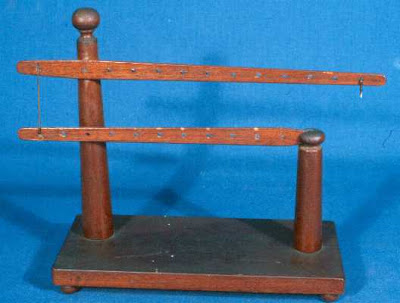 A compound lever.
A compound lever.
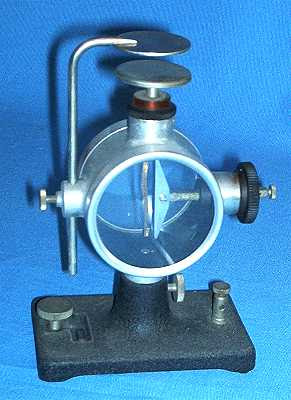 This is a bench top instrument for the observation of the ionizing effects of radiation, high voltages, flames, etc....the Zeleny Electroscope ca. 1920.
This is a bench top instrument for the observation of the ionizing effects of radiation, high voltages, flames, etc....the Zeleny Electroscope ca. 1920.
 It is an electromechanical devices that produce "static electricity" [Wimshurst Machine]--electricity at continuous direct current high voltage. Now rarely used except for physics's classroom demonstrations and monster creations.
It is an electromechanical devices that produce "static electricity" [Wimshurst Machine]--electricity at continuous direct current high voltage. Now rarely used except for physics's classroom demonstrations and monster creations.
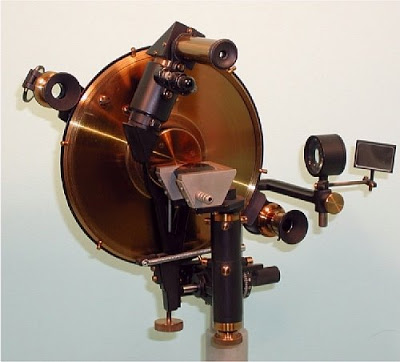 This is the Pulfrich Pattern Refractometer. As a sale catalog states:
This is the Pulfrich Pattern Refractometer. As a sale catalog states:
"A fine and rare Pulfrich pattern Refractometer by Bellingham and Stanley. This Pulfrich refractometer is a research quality instrument based on a design by Pulfrich which requires no calibration since it measures refractive index from fundamental optical principles. It was renown as the most precise instrument capable of accuracies in the range of +/- 0.00001 in refractive index. The instrument required great skill to operate correctly and determination of R.I. took a great deal of time."
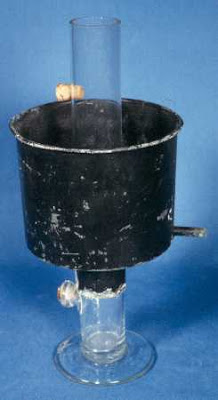 It is called "Hope's Apparatus" after the chemist Thomas Hope [1766-1844] [Edinburgh University]. The devise was an experiment to observe the contraction of water by heat at low temperatures. The large trough contained a freezing mixture and a thermometer was placed in the glass cylinder at the top and bottom [the openings can be seen at the left]. After some time it was observed that the denser water collected at the bottom at a temperature of 4° C and remained at that temperature illustrating the maximum density of water--a phenomenon observed by lake fish when the surface water froze.
It is called "Hope's Apparatus" after the chemist Thomas Hope [1766-1844] [Edinburgh University]. The devise was an experiment to observe the contraction of water by heat at low temperatures. The large trough contained a freezing mixture and a thermometer was placed in the glass cylinder at the top and bottom [the openings can be seen at the left]. After some time it was observed that the denser water collected at the bottom at a temperature of 4° C and remained at that temperature illustrating the maximum density of water--a phenomenon observed by lake fish when the surface water froze.
 The instrument is the Bourdon Tube illustrating the "aneroid barometer" to measure atmospheric pressure. Aneroid barometers have a sealed bellows that can expand and contract as a function of external pressure changes. This makes the instrument portable. It's non-portable counterpart is the "manometer" which relies on mercury and must be kept in a vertical position.
The instrument is the Bourdon Tube illustrating the "aneroid barometer" to measure atmospheric pressure. Aneroid barometers have a sealed bellows that can expand and contract as a function of external pressure changes. This makes the instrument portable. It's non-portable counterpart is the "manometer" which relies on mercury and must be kept in a vertical position.
 This is simply a transformer [step-up or step-down] from about 1914 and manufactured by C. H. Stoelting Company of Chicago, Illinois.
This is simply a transformer [step-up or step-down] from about 1914 and manufactured by C. H. Stoelting Company of Chicago, Illinois.
 Known as a "slide-wire potentiometer" invented in 1841 by Johann Christian Poggendorff [1796-1877]. Poggendorff was also the editor of the "Annalen de Physik und Chemie" [1824 to 1876].
Known as a "slide-wire potentiometer" invented in 1841 by Johann Christian Poggendorff [1796-1877]. Poggendorff was also the editor of the "Annalen de Physik und Chemie" [1824 to 1876].
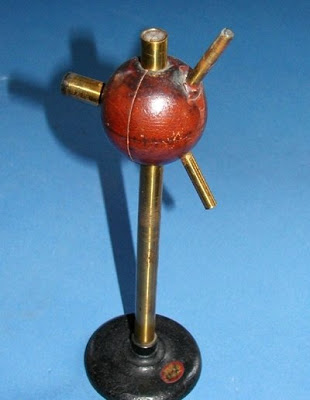 This is called the "Manometric Flame Apparatus" and was the standard for observing and measuring the wave shapes of sounds...sort of an early oscilloscope. It lost use when better and more accurate electrical devices came into vogue.
This is called the "Manometric Flame Apparatus" and was the standard for observing and measuring the wave shapes of sounds...sort of an early oscilloscope. It lost use when better and more accurate electrical devices came into vogue.
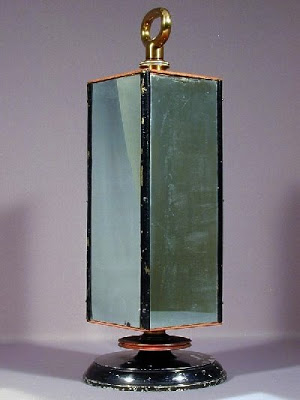 This apparatus was for the demonstration of mechanical oscillations. Interesting to note that the mirrored surfaces were of a complex coating [platinum chloride, lead borate, and lead oxide] to reduce double reflection. It was set into motion by hand spinning.
This apparatus was for the demonstration of mechanical oscillations. Interesting to note that the mirrored surfaces were of a complex coating [platinum chloride, lead borate, and lead oxide] to reduce double reflection. It was set into motion by hand spinning.
 It is an adjustable capacitor apparatus from the collection at Cornell University. The brass plates are 57.5 inches in diameter with a 35 inch adjustment span on insulated threaded shafts. Even though this one is unmarked it does resemble the 1911 type manufactured by W.G. Pye & Co. [Cambridge, England]. Original cost was about $70 bucks. These old samples of physics apparatus sometimes reach the realm of art: Construction, casting, wood selection, metal lathe work.
It is an adjustable capacitor apparatus from the collection at Cornell University. The brass plates are 57.5 inches in diameter with a 35 inch adjustment span on insulated threaded shafts. Even though this one is unmarked it does resemble the 1911 type manufactured by W.G. Pye & Co. [Cambridge, England]. Original cost was about $70 bucks. These old samples of physics apparatus sometimes reach the realm of art: Construction, casting, wood selection, metal lathe work.
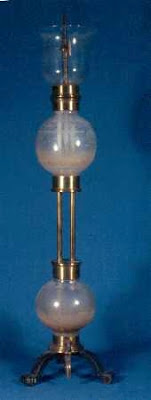 It is "Hero's Fountain" and is named after Hero [Heron] who lived in Alexandria about 120 B.C. It essentially is a pneumatic device illustrating the use of "...both gravity and pressure to create a continuous fountain. Begin the fountain by pouring water into the funnel. Gravity pulls the water down the first tube and into the lower bottle. Increasing the amount of water in the lower bottle increases the air pressure in that bottle and in the second tube. The lower bottle is, in effect, "blowing" air into the upper bottle. This causes the air pressure to increase in the upper bottle, forcing water up the third tube. The water eventually pours out the top of the third tube, back into the funnel, and the cycle starts again. As long as you put in enough water, the Hero's Fountain will continue, using gravity and pressure, to operate until there is no more water in the upper bottle."
It is "Hero's Fountain" and is named after Hero [Heron] who lived in Alexandria about 120 B.C. It essentially is a pneumatic device illustrating the use of "...both gravity and pressure to create a continuous fountain. Begin the fountain by pouring water into the funnel. Gravity pulls the water down the first tube and into the lower bottle. Increasing the amount of water in the lower bottle increases the air pressure in that bottle and in the second tube. The lower bottle is, in effect, "blowing" air into the upper bottle. This causes the air pressure to increase in the upper bottle, forcing water up the third tube. The water eventually pours out the top of the third tube, back into the funnel, and the cycle starts again. As long as you put in enough water, the Hero's Fountain will continue, using gravity and pressure, to operate until there is no more water in the upper bottle."
 FOCUS X-RAY TUBE
FOCUS X-RAY TUBE
c.a. 1900
"Blown glass tube with anode, anticathode and focus cathode. Electrodes are connected to soldered terminals by wires. Side discharge tube with anode and cathode. Sealed, rubber capped exhaust tube. Glass discoloured due to radiation damage or metal deposits. The cathode focuses an electron beam to a small spot on the anticathode, where they are absorbed. This excites atoms in the anticathode, which relax by emitting X-ray photons. X-rays emerge from the side of the tube and since they emanate from a small spot on the anticathode, X-ray images are sharp. The extra anode allows a larger current to pass without damaging the anticathode. The side tube is used to release (previously occluded) gas into the main chamber. This is to counteract the occlusion of gas that occurs during operation and which lowers the pressure until the discharge ceases. Tubes of this kind were used in medicine and for further X-ray experimentation. "
 This is a governor mechanism. In fact, the term "balls out" comes from this exact device. and back in the steam era it was necessary to maintain a constant engine speed invariant of load capacities on specific machinery. In silent cameras it enabled a skilled cameraman the ability to maintain a consistent film speed for smoother series of frame by frame exposure.
This is a governor mechanism. In fact, the term "balls out" comes from this exact device. and back in the steam era it was necessary to maintain a constant engine speed invariant of load capacities on specific machinery. In silent cameras it enabled a skilled cameraman the ability to maintain a consistent film speed for smoother series of frame by frame exposure.
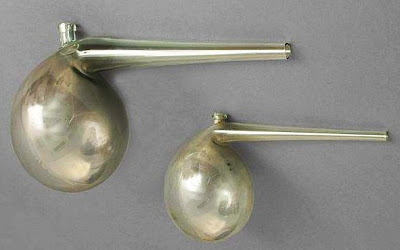
Instruments for Natural Philosophy
Medieval and Renaissance Scientific Instruments
Museum of Physics
National Museum of American History
University of Nebraska
University of Queensland
University of Toronto
- The Glass Jar That Delivered A Jolt
Electrical Sportsman A polychromed, hand-painted model of a hunter resting on a walnut base measuring 13" x 4" with a Leyden jar and pith birds (missing.) This electrostatic demonstration apparatus was sold by many different manufacturers of philosophical...
- Toy Rocket
Ask This Old House How to Build a Water Rocket Host Kevin O'Connor and a middle school teacher show some eager students how to build a model rocket launcher using commonly available household and hardware store items. Video Alternate: Water rockets...
- Alembic...distillation Apparatus
Alchymia by Andreas Libavius 1606 A. Alembic with long delivery tube. B. Alembic with short delivery tube. C, B, H. Closed alembics. E. Tin alembic. F, G. Sublimation heads. I, T. Closed alembics with tubus. K. Bell-shaped head. L. Elongated alembic....
- Thomas B. Greenslade Jr. And Scientific Instruments
I wonder if Thomas B. Greenslade Jr. knows Richard Zitto...a fellow science instrument collector. When I was working in radio, the station needed to replace the transmitter's broadcasting vacuum tube. Egads, $20,000. Wish I had it and my whole vacuum...
- Scientific Instruments--richard Zitto's Collection
Richard Zitto is seen holding a rare two-cylinder vacuum pump from the 1850s, made by the Benjamin Pike Company, which produced physics apparatus in New York City. Zitto is in talks with the Smithsonian Institution to possibly put the antique vacuum pump...
Philosophy
Physics instruments of days passed
 It is a simple instrument manufactured by the W. M. Welch Scientific Company of Chicago, Illinois c.a. 1922 for measuring "foot-candles" of illumination of any surface. A "foot-candle" is a unit of illumination on a surface that is everywhere one foot from a point source of one candle or equal to one lumen per square foot which is equal to one "lux". Argh...confusing? Forget it all and just read the position dial of your light meter.
It is a simple instrument manufactured by the W. M. Welch Scientific Company of Chicago, Illinois c.a. 1922 for measuring "foot-candles" of illumination of any surface. A "foot-candle" is a unit of illumination on a surface that is everywhere one foot from a point source of one candle or equal to one lumen per square foot which is equal to one "lux". Argh...confusing? Forget it all and just read the position dial of your light meter. It's called "Bohnenberger's Apparatus" [Johann von Bohnenberger--1817]. Gyroscopes were the product of Leon Foucault in 1852. This device antedates Foucault's by a few years and has the following text:
It's called "Bohnenberger's Apparatus" [Johann von Bohnenberger--1817]. Gyroscopes were the product of Leon Foucault in 1852. This device antedates Foucault's by a few years and has the following text:"This apparatus consists of three movable rings, ..., mounted on a stout base. The two inner rings are mounted on pivots; those on the smallest ring at right angles to the middle one; in the smallest ring is supported a metal ball, having a roller on one of its pivots; around the roller a string may be wound, and when pulled off a rapid rotary motion may be given to the ball. This motion may be given with the axis in any position required, and when communicated, the ring supporting the ball will resist considerable effort to alter its position, and whatever way the instrument may be turned, its axis will continue to maintain the position it had when set in motion, illustrating the inertia, or that property of matter which resists any change of state, whether of rest or motion."--Benjamin Pike, Jr.'s Illustrated Descriptive Catalogue of Optical, Mathematical and Philosophical Instruments: "Bohnenberger's Machine, 1856 edition, Volume One.
 A compound lever.
A compound lever. This is a bench top instrument for the observation of the ionizing effects of radiation, high voltages, flames, etc....the Zeleny Electroscope ca. 1920.
This is a bench top instrument for the observation of the ionizing effects of radiation, high voltages, flames, etc....the Zeleny Electroscope ca. 1920. It is an electromechanical devices that produce "static electricity" [Wimshurst Machine]--electricity at continuous direct current high voltage. Now rarely used except for physics's classroom demonstrations and monster creations.
It is an electromechanical devices that produce "static electricity" [Wimshurst Machine]--electricity at continuous direct current high voltage. Now rarely used except for physics's classroom demonstrations and monster creations.  This is the Pulfrich Pattern Refractometer. As a sale catalog states:
This is the Pulfrich Pattern Refractometer. As a sale catalog states:"A fine and rare Pulfrich pattern Refractometer by Bellingham and Stanley. This Pulfrich refractometer is a research quality instrument based on a design by Pulfrich which requires no calibration since it measures refractive index from fundamental optical principles. It was renown as the most precise instrument capable of accuracies in the range of +/- 0.00001 in refractive index. The instrument required great skill to operate correctly and determination of R.I. took a great deal of time."
 It is called "Hope's Apparatus" after the chemist Thomas Hope [1766-1844] [Edinburgh University]. The devise was an experiment to observe the contraction of water by heat at low temperatures. The large trough contained a freezing mixture and a thermometer was placed in the glass cylinder at the top and bottom [the openings can be seen at the left]. After some time it was observed that the denser water collected at the bottom at a temperature of 4° C and remained at that temperature illustrating the maximum density of water--a phenomenon observed by lake fish when the surface water froze.
It is called "Hope's Apparatus" after the chemist Thomas Hope [1766-1844] [Edinburgh University]. The devise was an experiment to observe the contraction of water by heat at low temperatures. The large trough contained a freezing mixture and a thermometer was placed in the glass cylinder at the top and bottom [the openings can be seen at the left]. After some time it was observed that the denser water collected at the bottom at a temperature of 4° C and remained at that temperature illustrating the maximum density of water--a phenomenon observed by lake fish when the surface water froze. The instrument is the Bourdon Tube illustrating the "aneroid barometer" to measure atmospheric pressure. Aneroid barometers have a sealed bellows that can expand and contract as a function of external pressure changes. This makes the instrument portable. It's non-portable counterpart is the "manometer" which relies on mercury and must be kept in a vertical position.
The instrument is the Bourdon Tube illustrating the "aneroid barometer" to measure atmospheric pressure. Aneroid barometers have a sealed bellows that can expand and contract as a function of external pressure changes. This makes the instrument portable. It's non-portable counterpart is the "manometer" which relies on mercury and must be kept in a vertical position. This is simply a transformer [step-up or step-down] from about 1914 and manufactured by C. H. Stoelting Company of Chicago, Illinois.
This is simply a transformer [step-up or step-down] from about 1914 and manufactured by C. H. Stoelting Company of Chicago, Illinois.  Known as a "slide-wire potentiometer" invented in 1841 by Johann Christian Poggendorff [1796-1877]. Poggendorff was also the editor of the "Annalen de Physik und Chemie" [1824 to 1876].
Known as a "slide-wire potentiometer" invented in 1841 by Johann Christian Poggendorff [1796-1877]. Poggendorff was also the editor of the "Annalen de Physik und Chemie" [1824 to 1876].  This is called the "Manometric Flame Apparatus" and was the standard for observing and measuring the wave shapes of sounds...sort of an early oscilloscope. It lost use when better and more accurate electrical devices came into vogue.
This is called the "Manometric Flame Apparatus" and was the standard for observing and measuring the wave shapes of sounds...sort of an early oscilloscope. It lost use when better and more accurate electrical devices came into vogue. This apparatus was for the demonstration of mechanical oscillations. Interesting to note that the mirrored surfaces were of a complex coating [platinum chloride, lead borate, and lead oxide] to reduce double reflection. It was set into motion by hand spinning.
This apparatus was for the demonstration of mechanical oscillations. Interesting to note that the mirrored surfaces were of a complex coating [platinum chloride, lead borate, and lead oxide] to reduce double reflection. It was set into motion by hand spinning.  It is an adjustable capacitor apparatus from the collection at Cornell University. The brass plates are 57.5 inches in diameter with a 35 inch adjustment span on insulated threaded shafts. Even though this one is unmarked it does resemble the 1911 type manufactured by W.G. Pye & Co. [Cambridge, England]. Original cost was about $70 bucks. These old samples of physics apparatus sometimes reach the realm of art: Construction, casting, wood selection, metal lathe work.
It is an adjustable capacitor apparatus from the collection at Cornell University. The brass plates are 57.5 inches in diameter with a 35 inch adjustment span on insulated threaded shafts. Even though this one is unmarked it does resemble the 1911 type manufactured by W.G. Pye & Co. [Cambridge, England]. Original cost was about $70 bucks. These old samples of physics apparatus sometimes reach the realm of art: Construction, casting, wood selection, metal lathe work.  It is "Hero's Fountain" and is named after Hero [Heron] who lived in Alexandria about 120 B.C. It essentially is a pneumatic device illustrating the use of "...both gravity and pressure to create a continuous fountain. Begin the fountain by pouring water into the funnel. Gravity pulls the water down the first tube and into the lower bottle. Increasing the amount of water in the lower bottle increases the air pressure in that bottle and in the second tube. The lower bottle is, in effect, "blowing" air into the upper bottle. This causes the air pressure to increase in the upper bottle, forcing water up the third tube. The water eventually pours out the top of the third tube, back into the funnel, and the cycle starts again. As long as you put in enough water, the Hero's Fountain will continue, using gravity and pressure, to operate until there is no more water in the upper bottle."
It is "Hero's Fountain" and is named after Hero [Heron] who lived in Alexandria about 120 B.C. It essentially is a pneumatic device illustrating the use of "...both gravity and pressure to create a continuous fountain. Begin the fountain by pouring water into the funnel. Gravity pulls the water down the first tube and into the lower bottle. Increasing the amount of water in the lower bottle increases the air pressure in that bottle and in the second tube. The lower bottle is, in effect, "blowing" air into the upper bottle. This causes the air pressure to increase in the upper bottle, forcing water up the third tube. The water eventually pours out the top of the third tube, back into the funnel, and the cycle starts again. As long as you put in enough water, the Hero's Fountain will continue, using gravity and pressure, to operate until there is no more water in the upper bottle." FOCUS X-RAY TUBE
FOCUS X-RAY TUBE c.a. 1900
"Blown glass tube with anode, anticathode and focus cathode. Electrodes are connected to soldered terminals by wires. Side discharge tube with anode and cathode. Sealed, rubber capped exhaust tube. Glass discoloured due to radiation damage or metal deposits. The cathode focuses an electron beam to a small spot on the anticathode, where they are absorbed. This excites atoms in the anticathode, which relax by emitting X-ray photons. X-rays emerge from the side of the tube and since they emanate from a small spot on the anticathode, X-ray images are sharp. The extra anode allows a larger current to pass without damaging the anticathode. The side tube is used to release (previously occluded) gas into the main chamber. This is to counteract the occlusion of gas that occurs during operation and which lowers the pressure until the discharge ceases. Tubes of this kind were used in medicine and for further X-ray experimentation. "
 This is a governor mechanism. In fact, the term "balls out" comes from this exact device. and back in the steam era it was necessary to maintain a constant engine speed invariant of load capacities on specific machinery. In silent cameras it enabled a skilled cameraman the ability to maintain a consistent film speed for smoother series of frame by frame exposure.
This is a governor mechanism. In fact, the term "balls out" comes from this exact device. and back in the steam era it was necessary to maintain a constant engine speed invariant of load capacities on specific machinery. In silent cameras it enabled a skilled cameraman the ability to maintain a consistent film speed for smoother series of frame by frame exposure.Other repositories of scientific instruments and apparatus:
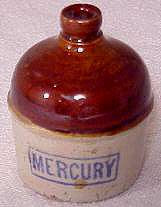

Instruments for Natural Philosophy
Medieval and Renaissance Scientific Instruments
Museum of Physics
National Museum of American History
University of Nebraska
University of Queensland
University of Toronto
- The Glass Jar That Delivered A Jolt
Electrical Sportsman A polychromed, hand-painted model of a hunter resting on a walnut base measuring 13" x 4" with a Leyden jar and pith birds (missing.) This electrostatic demonstration apparatus was sold by many different manufacturers of philosophical...
- Toy Rocket
Ask This Old House How to Build a Water Rocket Host Kevin O'Connor and a middle school teacher show some eager students how to build a model rocket launcher using commonly available household and hardware store items. Video Alternate: Water rockets...
- Alembic...distillation Apparatus
Alchymia by Andreas Libavius 1606 A. Alembic with long delivery tube. B. Alembic with short delivery tube. C, B, H. Closed alembics. E. Tin alembic. F, G. Sublimation heads. I, T. Closed alembics with tubus. K. Bell-shaped head. L. Elongated alembic....
- Thomas B. Greenslade Jr. And Scientific Instruments
I wonder if Thomas B. Greenslade Jr. knows Richard Zitto...a fellow science instrument collector. When I was working in radio, the station needed to replace the transmitter's broadcasting vacuum tube. Egads, $20,000. Wish I had it and my whole vacuum...
- Scientific Instruments--richard Zitto's Collection
Richard Zitto is seen holding a rare two-cylinder vacuum pump from the 1850s, made by the Benjamin Pike Company, which produced physics apparatus in New York City. Zitto is in talks with the Smithsonian Institution to possibly put the antique vacuum pump...
